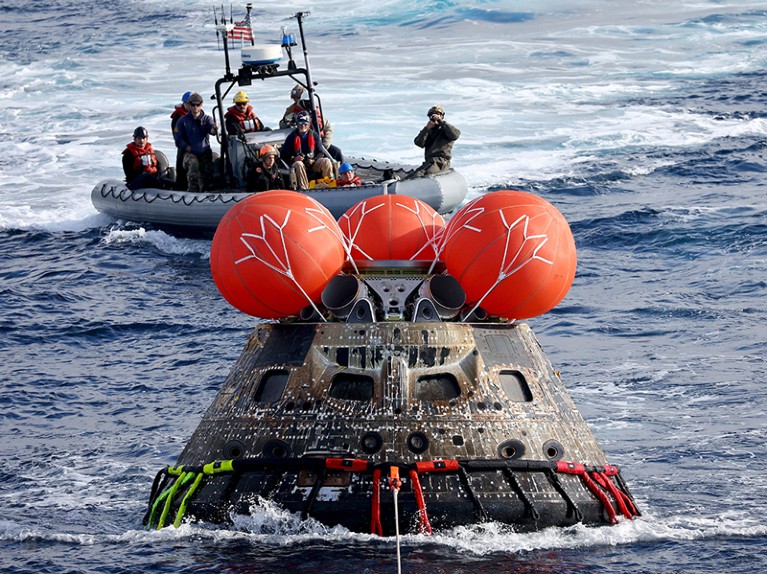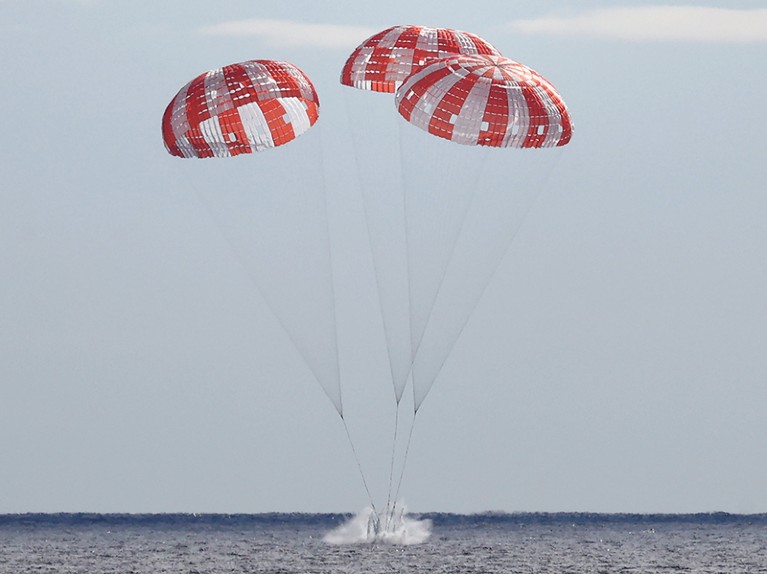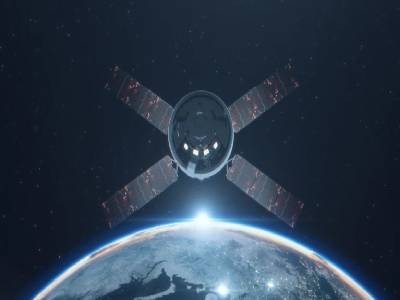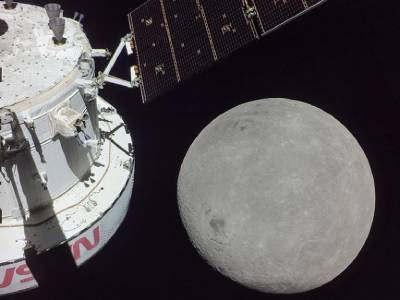
NASA’s Orion capsule was recovered off the coast of Baja California, Mexico, on 11 December.Credit: Mario Tama/AFP/Getty
NASA’s Orion capsule splashed down safely off the coast of Mexico on 11 December, bringing a close to the first test flight of a new spaceship meant to carry people back to the Moon. Researchers are excited to now download data from the successful 25-day flight to the Moon and back, known as Artemis I.
It sets the stage for Orion’s next trip, which will be a loop around the Moon with astronauts on board. But that flight, Artemis II, won’t come before 2024 at the earliest.
NASA’s Orion spacecraft prepares for blazing return to Earth
“It’s time to celebrate — then we gotta get ready for Artemis II,” says Vanessa Wyche, director of NASA’s Johnson Space Center in Houston, Texas.
The two-year gap between Artemis I and Artemis II comes in part because NASA needs to retrieve parts from the capsule that just splashed down, then test them rigorously before installing them on the next Orion spaceship. The gap threatens to dampen momentum for the fledgling Artemis programme, which NASA envisions as the successor to its Apollo programme that sent astronauts to the Moon between 1969 and 1972. Artemis III, planned for no earlier than 2025 but likely to fly later in the decade, would be a crewed lunar landing at the Moon’s south pole, where researchers want to study ice nestled in shadowed craters.
Textbook landing
Orion’s return to Earth came 50 years to the day after Eugene Cernan and Harrison Schmitt became the last humans to land on the Moon, on the Apollo 17 mission.
As it flew back towards Earth and prepared to hit the atmosphere, the Orion capsule separated from the module that had been providing guidance and propulsion during its journey. The European Space Agency-built module burned up over the South Pacific Ocean. Orion then continued alone into a fiery re-entry, in which friction with the atmosphere sent temperatures soaring to 2,800 °C. A heat shield, made from the same materials that kept Apollo astronauts safe in their capsule during re-entry, protected the vehicle.

After re-entering Earth’s atmosphere, Orion slowed down with the help of multiple parachutes.Credit: Mario Tama/Getty
As planned, Orion descended into Earth’s atmosphere and then skipped up for a few minutes, like a stone skipping across a pond. This dramatic maneouvre, never before tested for a passenger spaceship, allowed the capsule time to adjust the distance it travelled through the atmosphere so it could land more precisely. Slowed by parachutes, Orion splashed down less than 10 kilometres from the US Navy ship that was waiting for it off the western coast of Baja California. Although it was originally intended to land off San Diego, California, the landing zone was moved several hundred kilometres south because of concerns that weather would cause high seas.
NASA engineers will now analyse data from sensors inside the capsule, as well as other information gathered during the flight and splashdown, to decide what needs tweaking before Artemis II. “This is going to tell us what we need to do, change or modify for the next mission,” says Shannon Walker, a NASA astronaut.
Unpacking the data
A set of flight computers on board Orion will now need to be retrieved, analysed and approved before they can be installed in the capsule that will fly on Artemis II — a crucial step that will take time. The decision to re-use these computers, rather than fly new ones, was a cost-saving move taken years ago.
NASA’s Orion spacecraft reaches the Moon — in pictures
Engineers will also be retrieving data from scientific sensors, such as data on radiation exposure within the capsule, so that Artemis II can fly as safely as possible with astronauts on board. “We’re really looking forward to unpacking everything that we had to learn from this mission as we prepare for the next one,” says Emily Nelson, chief flight director at the Johnson Space Center.
Construction on other components for the Artemis II flight is well underway. The next European-built service module is already at the Kennedy Space Center in Florida and being assembled with the next Orion capsule.
NASA plans to announce which astronauts will fly on Artemis II in the coming weeks, Wyche says.



